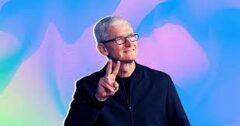When Tim Cook unveils Apple’s new “mixed-reality” headset later this year, he won’t just be showing off the tech giant’s latest shiny gadget.
The Apple chief will also be guaranteeing his legacy including the launch of a next-generation hardware product that some inside the company believe might one day rival the iPhone.
After seven years in development — twice as long as the iPhone — the tech giant is widely expected to unveil a headset featuring both virtual and augmented reality as soon as June.
The stakes are high for Cook. The headset will be Apple’s first new computing platform to have been developed entirely under his leadership. The iPhone, iPad and even Watch were all originally conceived under Apple’s co-founder Steve Jobs, who died in 2011.
Apple’s growth during Cook’s tenure has been spectacular, growing its market capitalisation from around $350bn in 2011 to around $2.4tn today. But despite the twin hit launches of Apple Watch in 2015 and AirPods a year later, which have helped turn its accessories division into a $41bn business, the company has been accused of iterating on past ideas rather than breaking new ground.
“They have huge pressure to ship” the headset, said a former Apple engineer who worked on the product’s development. “They have been postponing the launch each year for the past [few] years.”
The timing of the launch has been a source of tension since the project began in early 2016, according to multiple people familiar with Apple’s internal discussions.
Apple’s operations team wanted to ship a “version one” product, a ski goggle-like headset that will allow users to watch immersive 3D video, perform interactive workouts or chat with realistic avatars through a revamped FaceTime.
But Apple’s famed industrial design team had cautioned patience, wanting to delay until a more lightweight version of AR glasses became technically feasible. Most in the tech industry expect that to take several more years.
In deciding to press ahead with a debut this year, Cook has sided with operations chief Jeff Williams, according to two people familiar with Apple’s decision-making, and overruled the early objections from Apple’s designers to wait for the tech to catch up with their vision.
Just a few years ago, going against the wishes of Apple’s all-powerful design team would have been unthinkable. But since the departure of its longtime leader Jony Ive in 2019, Apple’s structure has been reshuffled, with design now reporting to Williams.
Ive’s former role as chief design officer was split in two, with Evans Hankey on hardware and Alan Dye on software. However, Hankey announced last October that she would be leaving within six months, contributing to significant staff turnover in the division over recent years.
A former Apple engineer said operations taking more control over product development is a “logical progression” of Apple’s trajectory under Cook. The best part of working at Apple, this person said, used to be coming up with engineering solutions to the “insane requirements” of the design team, but that has changed in recent years.
Apple declined to comment.
Apple’s 12-person executive team reflects how the company’s focus has shifted under Cook, himself a former operations chief. Four of the 12 members have risen through Apple’s operations ranks, whereas nobody has succeeded Ive as chief design officer, who steered the development of the iMac, iPod and iPhone and Watch.
While the success or failure of the headset could have huge implications for Cook’s reputation as a steady-handed leader and Apple’s perceived ability to keep innovating, its initial sales will probably be a rounding error.
Apple is only expecting to sell around a million units of its headset in its first 12 months, according to two people familiar with its planning, fewer than the first generations of the iPhone or Apple Watch did in the year following their launch.
The complex device, which will contain an array of cameras and high-resolution screens, is expected to cost around $3,000, triple the price of Meta’s Quest Pro, potentially limiting its appeal.
Generating even $3bn in annual sales would be a tiny fraction of Apple’s revenues of around $400bn last year.

